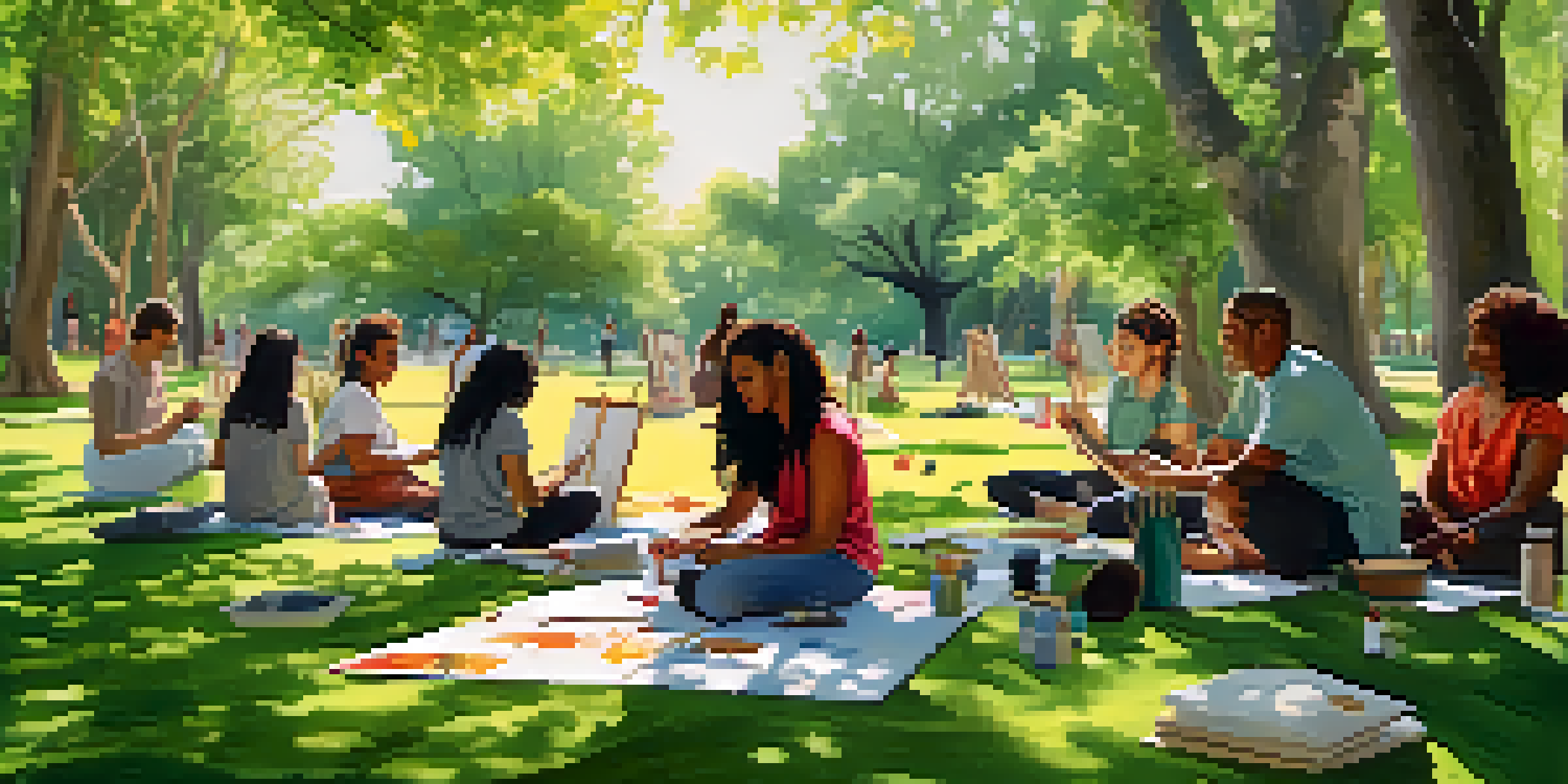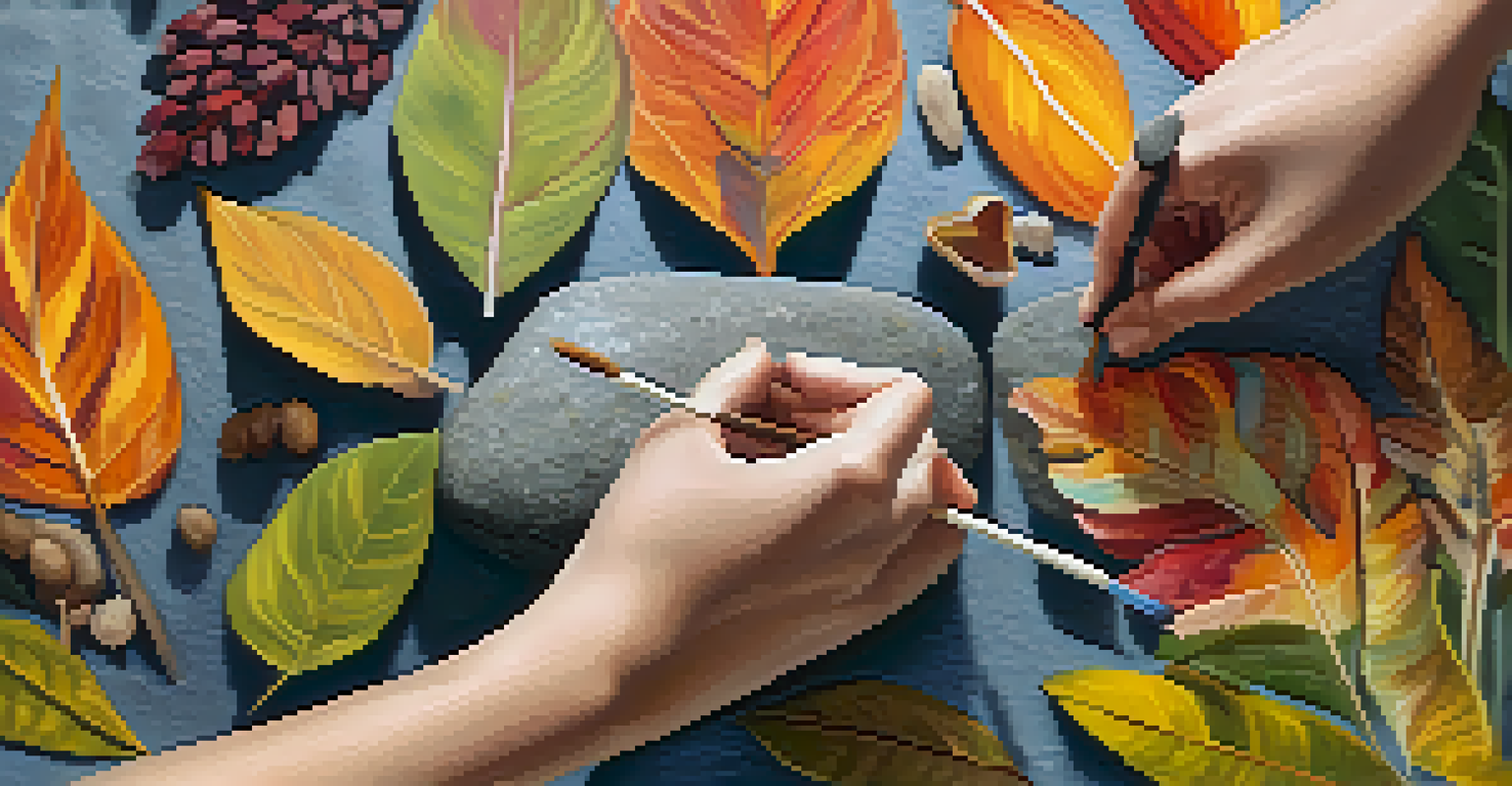Art Therapy and Nature: Healing through Sustainable Art

Understanding Art Therapy: A Holistic Approach to Healing
Art therapy combines creative expression with psychological healing, allowing individuals to explore their emotions through art. This therapeutic practice leverages the creative process to help people communicate feelings that might be hard to articulate verbally. It serves as an emotional outlet, offering a safe space for self-discovery and personal growth.
Art is not what you see, but what you make others see.
By engaging in artistic activities, individuals can process trauma, reduce anxiety, and enhance overall mental well-being. The act of creating art can be meditative, fostering a sense of calm and presence. For many, this process becomes a transformative journey, where they not only heal but also discover new aspects of themselves.
The integration of art therapy into mental health care has gained recognition over the years as a powerful tool. It’s not just about painting or drawing; it encompasses various creative forms, including sculpture, dance, and music. This versatility makes art therapy accessible and appealing to a broad audience.
Nature as a Source of Inspiration and Healing
Nature has an innate ability to soothe and inspire us, making it a perfect backdrop for art therapy. The sights, sounds, and textures of the natural world can foster a sense of peace and connection, enhancing the therapeutic experience. Engaging with nature allows individuals to escape the hustle and bustle of everyday life and tap into their inner creativity.

Studies have shown that spending time in nature can reduce stress, lower blood pressure, and improve mood. When combined with art therapy, the benefits multiply, as the creative process helps to solidify these positive effects. For example, creating art outdoors can deepen one’s appreciation for the environment while simultaneously promoting mental well-being.
Art Therapy Enhances Emotional Healing
Art therapy allows individuals to express and process emotions creatively, facilitating personal growth and emotional well-being.
This connection to nature is not just beneficial; it’s essential in our increasingly urbanized world. Incorporating elements of the natural landscape into art therapy sessions can create a holistic healing experience, promoting a sense of belonging and harmony with the earth.
Sustainable Art: Merging Creativity with Environmental Awareness
Sustainable art takes the concept of eco-friendly practices and applies it to the creative process. It encourages artists and participants to use materials that are either recycled or sourced sustainably, creating a deeper connection to the environment. This approach not only reduces waste but also promotes mindfulness about our impact on the planet.
In every walk with nature, one receives far more than he seeks.
By utilizing natural materials, such as leaves, stones, or clay, artists can create works that reflect the beauty of their surroundings. This practice fosters an appreciation for nature while also nurturing creativity. For many, the act of creating sustainable art becomes a form of activism, highlighting the importance of environmental conservation.
Engaging in sustainable art can also serve as a powerful educational tool during therapy sessions, encouraging participants to reflect on their relationship with nature. It opens up discussions about sustainability and the role each person can play in protecting the environment, reinforcing the idea that healing can extend beyond the individual to encompass the planet.
The Therapeutic Benefits of Outdoor Art Therapy
Outdoor art therapy sessions offer a unique setting that enhances the therapeutic experience. Being outside allows clients to immerse themselves in the environment, engaging all their senses. This multisensory experience can trigger memories and emotions that might not surface in a traditional indoor setting.
Participants often report feeling more relaxed and open when creating art in nature. The fresh air, natural light, and sounds of wildlife contribute to a serene atmosphere that can ease anxiety and foster creativity. As they paint a landscape or sculpt with natural materials, clients may find themselves more in touch with their feelings and thoughts.
Nature Boosts Art Therapy Benefits
Engaging with nature during art therapy deepens the therapeutic experience, reducing stress and enhancing creativity.
Moreover, outdoor art therapy encourages social interaction, as participants may collaborate on projects or share their creations. This sense of community can enhance the healing process, providing support and understanding from others who share similar experiences.
Creating Art from Nature: Techniques and Ideas
There are countless ways to create art using natural materials, and the options are limited only by one’s imagination. Common techniques include leaf printing, rock painting, or even making sculptures from twigs and mud. These activities not only encourage creativity but also foster a deeper appreciation for the beauty of the natural world.
Nature-inspired art can also take the form of photography, where participants capture the beauty around them. This practice encourages mindfulness, as individuals become more attuned to their environment. By focusing on the details, such as the colors of a sunset or the texture of bark, clients can cultivate a sense of gratitude and awareness.
Incorporating seasonal changes into art projects can also enhance the therapeutic experience. For instance, creating ephemeral art using fallen leaves in autumn or making flower crowns in spring can help individuals connect with the cycles of nature. This connection serves as a reminder of life’s impermanence, promoting acceptance and resilience.
Case Studies: Success Stories in Art Therapy and Nature
Numerous case studies highlight the effectiveness of combining art therapy with nature. One notable example involves a group of veterans who participated in outdoor art therapy sessions. By expressing their emotions through art in a tranquil natural setting, many found relief from PTSD symptoms and a renewed sense of purpose.
Another inspiring case involved children in urban settings who engaged in nature-based art therapy. Participants reported increased self-esteem and improved social skills after creating collaborative art projects in parks. The combination of nature and creativity allowed them to express their feelings in a safe and supportive environment.
Sustainable Art Promotes Awareness
Creating sustainable art fosters a connection to the environment, encouraging mindfulness and discussions about conservation.
These success stories demonstrate that art therapy, especially when intertwined with nature, can be a transformative experience. By fostering creativity and connection to the environment, individuals can find healing, empowerment, and a renewed sense of hope.
Getting Started: How to Incorporate Art Therapy and Nature
Starting your journey with art therapy and nature is easier than you might think. First, find a peaceful outdoor space where you feel comfortable and inspired. This could be a local park, a garden, or even your backyard. Bring along some simple art supplies, like sketchbooks, paints, or natural materials.
Consider setting aside regular time for creative exploration outdoors. Whether it’s a few hours each week or a dedicated day each month, consistency can help deepen your connection to both art and nature. Allow yourself to experiment without the pressure of perfection; the goal is self-expression rather than creating a masterpiece.

Lastly, don’t hesitate to seek guidance from a trained art therapist who specializes in nature-based therapies. They can provide valuable insights, techniques, and support to help you navigate your healing journey. Remember, the most important aspect is to enjoy the process and embrace the healing power of creativity and nature.